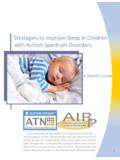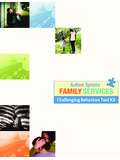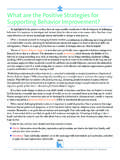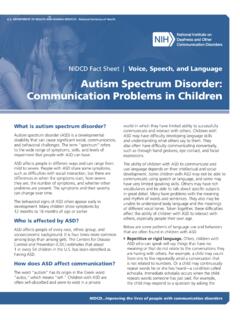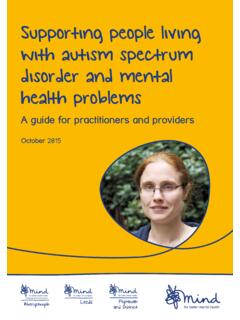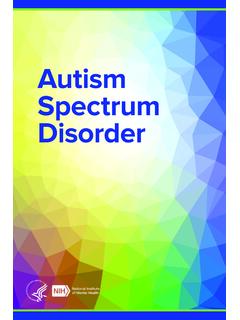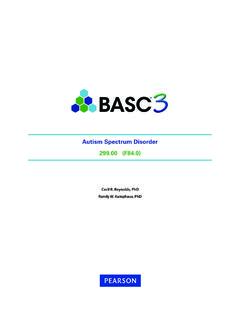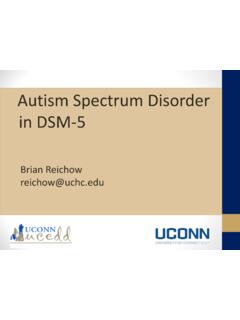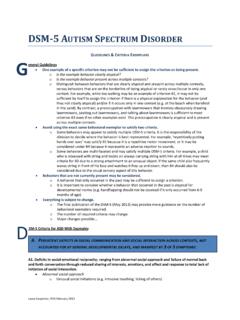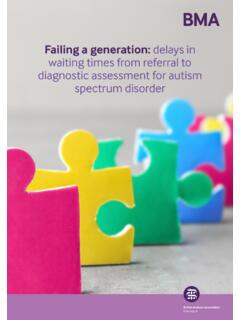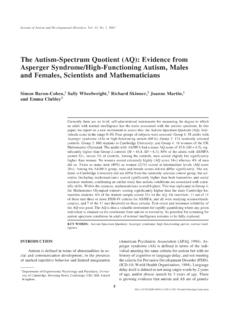Transcription of Autism and Medication: Safe and Careful Use - Autism Speaks
1 Autism and Medication: Safe and Careful UseThese materials are the product of on-going activities of the Autism Speaks Autism Treatment Network, a funded program of Autism Speaks . It is supported by cooperative agreement UA3 MC 11054 through the Department of Health and Human Services, Health Resources and Services Administration, Maternal and Child Health Research Program to the Massachusetts General Hospital. Its contents are solely the responsibility of the authors and do not necessarily represent the official views of the MCHB, HRSA, HHS, or Autism Speaks . Autism and Medication: Safe and Careful Use - An Autism Speaks ATN/AIR-P Tool Kit Table of Contents Introduction 3 Starting Medicines-An Overview 4-5 Target Symptoms 6 Looking for Medicine Effect 7 Ways To Measure And Track Changes In Target Symptoms 8 Side Effects 9 Monitoring For Common Side Effects 10-11 Managing Side Effects: Daytime Sleepiness 12 Managing Side Effects: Nighttime Sleep Problems 13 Managing Side Effects: Low Appetite 14-15 Managing Side Effects.
2 Large Appetite/Weight Gain 16-17 Ways to Increase Physical Activity 18 Tools & Resources 19 Question Prompt List 20 Common Medicines in Autism 21-22 Pill Swallowing 23-24 My Child s Medicine Log 25 Medicine Action Plan 26 Behavior Frequency Record #1 Monthly Chart 27 Behavior Frequency Record #2 Weekly Chart 28 Target Behavior Severity Scale #1 29 Target Behavior Severity Scale #2 30 Target Behavior Severity Scale #3 31 More Information 32 Acknowledgements 33 Autism and Medication: Safe and Careful Use - An Autism Speaks ATN/AIR-P Tool Kit Introduction This tool kit is for families of children with Autism * and other neurodevelopmental disorders who have decided to use medicines to help treat their child s challenging behavior or manage emotional issues.
3 Although this toolkit focuses on these few categories of medicines, the recommendations can be applied to most medicines. Many children with Autism have challenging behaviors or difficulties with their feelings and emotions. Many treatments help. Medicine is one of those treatments, but medicine is not right for every child. It is best to use medicine only after behavioral and educational methods have been tried. Families who are still deciding about the use of medicine will benefit from another tool kit. The name of the tool kit is Autism : Should My Child Take Medicine for Challenging Behavior: A Decision Aid for Parents of Children with Autism . Visit us online at CLICK HERE to download the tool kit This tool kit will help families: Work with their child s doctor or nurse to learn about medicines Get the information they need about recommended medicines Ask the right questions Give medicines safely Know if the treatment is working Know if there are side effects and what to do Be confident and informed advocates for their child This tool kit will help health care providers.
4 Explain medicine choices to families Teach families about watching for effectiveness Teach families about checking for side effects and good response Give information about managing common side effects Be clear with families about goals of treatment, possible risks and benefits *For the purposes of this tool kit, the term Autism will be used to describe children with all types of Autism Spectrum Disorders, including Autistic Disorder, Asperger s Disorder, and Pervasive Developmental Disorder Not Otherwise Specified (PDDNOS). Autism and Medication: Safe and Careful Use - An Autism Speaks ATN/AIR-P Tool Kit When thinking about starting medicines it is important to work closely with your child s health care team.
5 It is important to work together with someone who: Medicines are usually prescribed by a physician or nurse practitioner. Sometimes this is your child s pediatrician or primary care provider (PCP). Sometimes this is a specialist in child development, psychiatry, or neurology. Sharing your family s values and thoughts helps the doctor or nurse to understand your family. Once you have made a decision to try medicine, it is important to have the right information. This tool kit will help you to give the medicine safely, look for side effects, and know if the medicine is working. What type of medicine is best for my child? The type of medicine recommended will depend on the problems or target symptoms for your child.
6 Each medicine treats different target symptoms. Your doctor or nurse will think about possible side effects and benefits of the medicine for your child. If there is more than one option, he or she might discuss the pros and cons of those options. When medicine is prescribed, it is usually thought of as a trial to see if the medicine helps with the target symptoms. If improvement is not seen, medicine is usually stopped or changed. How long will it take my child s medicine to work? How long it takes a medicine to take effect is different for every medicine. Some medicines work within a few minutes. Some can take a month or more to see the full effect. It is important to talk with your child s doctor or nurse to find out how long it will take your child s medicine to work.
7 What is the right amount of medicine for my child? The dose of medicine is different for each child. Even with the same medicine, some children do well on a low dose and some children need higher doses. The dose depends on things like the symptom being treated, the child s age and weight, general health and the child s response to the medicine. Most doctors and nurses will start at a low dose and increase slowly until the symptom gets better. This helps to find the dose that is right for the child and to lessen side effects. How fast the dose is changed depends on the medicine. Later in this tool kit is a worksheet that can be used with your doctor or nurse to write down a schedule for increasing the medicine (MEDICINE ACTION PLAN,(page26).)
8 Knows you and your child Has experience working with children with Autism and behavior difficulties Is knowledgeable about the use of medicines in children with Autism Can help you know the possible risks and possible benefits of each medicine. Starting Medicines: An Overview Autism and Medication: Safe and Careful Use - An Autism Speaks ATN/AIR-P Tool Kit What are Side Effects? Side effects are negative or unwanted effects of a medicine. Later in this tool kit, you will find more information on SIDE EFFECTS (pages 9-18), ways to monitor for side effects, and ways to manage common side effects at home. Different medicines have different side effects. For that reason, some medicines have to be monitored much more closely than others.
9 What does Off-Label mean? Off-label use is when medicine is prescribed for a reason, to an age group , or at a dose that has not been approved by the Food and Drug Administration (FDA). Off-label drug use is common and legal. Many medicines are known to be helpful to treat an age group or a problem that is different from the condition for which the medicine is approved. It often takes many years to get additional FDA approvals, and drug companies do not always seek them. For this reason, doctors and patients do not have to wait for FDA approval to begin using the drug. Studies of new drugs in children are not common. For that reason, many medicines prescribed to children with Autism are off-label.
10 Should I tell other people my child is taking medicine? The decision to tell other people about your child s medicine use is best made by the family. Talking with your child s doctor or nurse might help you make this decision. If the medicine has side effects and other people take care of your child, it is important for them to know. However, sometimes it is helpful to try a medication without letting other people know. That way, reports on the child will not be affected by knowing he or she is taking medicine. It is always important to work with school teams and other people who work with your child to know how the medicine affects a child in different situations. Some families have trouble telling friends or family members that their child is taking medicine.






